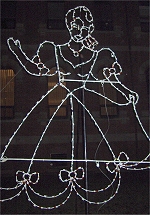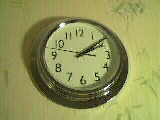If you are interested in the world of DVDs, there is a good, simple introduction in the Saturday National Post. Among other things they discuss which DVDs, in their opinion, have the best “special features.”
Doc Searls has been writing about Jabber again.
I mentioned the product here back in September, and I’ve been a contented user ever since. After having gone for years ignoring the instant messaging thing, I’ve become a convert, largely because for brother Johnny and I, working together under the Reinvented flag now, he on one coast and I on another, it is our lifeline.
In need of a procrastinatory activity for a Sunday afternoon, I decided to glue two concepts together: Jabber and Weblogs.com.
As I wrote here earlier, every time I update this website, I’m now also automatically updating the Weblogs.com list of recently updated sites.
So today I wrote a little Perl script that sucks in a list of sites I want to be updated about changes on, then, once an hour, goes to the XML version of the Weblogs.com site, and if any of the sites I’m interested in have changed, I get a pop-up message from Jabber saying “Hey, this site has changed.”
I’ll post the Perl source here once I get it cleaned up.
 Sixteen years ago I created a radio piece called “Phoning the Kremlin” which consisted entirely of a recording of my [failed] attempt to place a call to the [cold war-era] Kremlin in Moscow. Largely because of a delightful collection of operators and “overseas telephone sounds” and some backing music from Supertramp, the piece came off fairly well. Alas all track of the recording has been lost and it exists only in the aural memory of me and the listeners.
Sixteen years ago I created a radio piece called “Phoning the Kremlin” which consisted entirely of a recording of my [failed] attempt to place a call to the [cold war-era] Kremlin in Moscow. Largely because of a delightful collection of operators and “overseas telephone sounds” and some backing music from Supertramp, the piece came off fairly well. Alas all track of the recording has been lost and it exists only in the aural memory of me and the listeners.
A couple of years later I repeated the exercise by attempting to place a call to President Ronald Reagan at a meeting in Reykjavik. I failed again, but got some great tape of a U.S. Marine telling me that, no, I couldn’t speak to Mr. Reagan.
On today’s The Vinyl Cafe, host Stuart McLean demonstrated that he is a master of this art form, which might be called “telephone operator struggle art.”
Today’s episode consisted mostly of McLean’s attempt to get in touch with the Oxford, Nova Scotia family who had won his Christmas contest. Mere words cannot do justice to his audio escapades; suffice to say that it involved telephone operators in Sudbury, Kingston, Charlottetown and Halifax. And a taxi company. And he didn’t fail.
This kind of thing is like gold to a personality like Stuart McLean: he has the perfect combination of wry wit and persistence to take what could be Howard Stern-esque hijinks and transport it to a new level.
I bow before you, Stuart; you are a master.
Question to broadcast people: why is the web stream of KPIG a crystal-clear 128KB (CD-quality) while the web stream of CBC Toronto a muddy 8KB (poorer than AM radio quality)? Is it simply economics?
Addendum: The Windows Media Player version of CBC Toronto’s signal is a 16KB stream that sounds almost AM-quality.
On the lawn in front of the Coles Building just around the corner from our house is a collection of rocks. Or more properly boulders. There is one from each province in Canada, and a little brass plaque in the ground in front of each identifies their province and geological name.

I know nothing of the history of this endeavour, but it’s always struck me as a nice, simple idea. Of course as the son of a geologist, I am somewhat biased in this regard. But still, in the Nintendo age, a group of 10 boulders is, well, grounding.
Now it used to be that there was a very nice pathway that wended through the boulder garden. It was one of those very pleasant pathways made of a very pleasing material that wasn’t a “point A to point B” kind of path by rather a “take you on a tour of the boulders” kind of path. Because the route from our house to the coffee shop and Radio Shack and various other important institutions cuts through the boulder garden, I was a frequent visitor. And, of course, I took my father there several times for a sort of “cook’s tour” of the rocks.
Last fall, however, just in advance of the dreaded light orgy being inflicted on the downtown area, a bunch of Parks Canada workers showed up one day and began to rip up the pleasant pathway. In the space of a couple of days it was completely gone — sod was laid in its place — and replaced by a new “I-95” sort of pathway that is very “point A to point B.”
Thankfully the boulders themselves were left in place. However without a pleasant pathway, they are marooned in a sea of green grass. They are no longer a collection.
Why was this done?
Well, at least on the surface, it appears that it was simply to allow for the expansion of the aforementioned light glut. Specfically to provide room for for section of the light show that
 features beloved children’s nursery rhyme character Little Bo-peep being chased by a traditional Island elk pulling a wild-west stagecoach.
features beloved children’s nursery rhyme character Little Bo-peep being chased by a traditional Island elk pulling a wild-west stagecoach.
Given that the pastoral area in front of the Coles Building was, well, just home to the rocks pre-illumination, and given that it is now an important link on the orgy train, I can think of no other logical explanation for the change. Little Bo-peep has trumped geology.
If we can take any consolation from this at all, it is that planted squarely in front of Ms. Peep is a large chunk of Ontario gneiss.
![]()
As I see the story playing out, the marauding wild wagon, pulled by the irritated and thus bucking elk, is about to trample Little Bo-beep, as her way is impeded by a hulking boulder from Ontario. Beep survives the ordeal, of course, but emerges from her recovery some months later to open a small petting zoo on the outskirts of town with the elk as a featured attraction. She never returns to downtown Charlottetown. The gneiss, on the other hand, does what it’s always done: it just sits there.
Unfortunately, that’s the only comfort I have.
 Last Christmas I received not one but two Logitech QuickCam tethered video cameras. One got returned, and one stayed home.
Last Christmas I received not one but two Logitech QuickCam tethered video cameras. One got returned, and one stayed home.
The Grand Idea was that grandparents in Ontario would be able to occasionally drop in, via video, on the life of wee Oliver.
While nice in theory, the quality of Microsoft’s web video tools — NetMeeting, Portrait, etc. — is abysmal. Windows 2000, for example, comes with NetMeeting pre-installed. If your NetMeeting gets broken, you cannot fix it because you cannot uninstall it, and you can not re-install it. You are stuck. Forever. My particular problem is that I can start NetMeeting, but not end it. When I select “File \| Quit”, NetMeeting hangs. Forever. The only solution is to completely hard reboot the computer. Better living through quality software.
A rather nice piece of software is Pryme produced (and released for free) by a Danish chap named Simon Hiort-Lorenzen. It’s simple and easy to set up. And it’s bringing you the current time on the clock on my wall here at Reinvented World HQ.
I remember the first time I visited about Amazon.com. It was amazing. It worked. I could order anything.
They were an innovator. And they continue to be. Most of the interesting ideas about e-commerce either start at or are fully exploited by Amazon.com, from wish lists to easy charitable giving. And their ordering and fulfilment experience is always being refined. They are the market leader.
One of the nice features of their website is that you can see the history of your Amazon.com orders all the way back to 1995. Chapters has the same feature (I largely switched to them because their shipping is cheaper and faster in Canada). It’s an interesting voyage through my last half-decade to see what I ordered when:
- 1995
- 1996
- 1997
- 1998
- 2000
- 2001
Those of you on the humanities side of this weblog, please avert your eyes.
We’re now using the handy XML-RPC client for PHP to connect to UserLand’s Weblogs.com server whenever new content appears here.
If you are so inclined, you can watch the main Weblogs.com page or tie in to their changes.xml file for a XML-formatted version of when this (and gazillions of other) weblogs get modified.
We now return you to your previously scheduled weblog. Good evening.
I first learned about Atomica from Buzz at ActiveWords. ActiveWords is like a macro language for your operating system, and the
 Atomica service is one of the ways you can hook up words that you’re typing to their definitions.
Atomica service is one of the ways you can hook up words that you’re typing to their definitions.
When I was at Pop!Tech I happened, but pure random chance, to end up eating lunch one day with Bob Rosenschein, Atomica’s founder and CEO. I mentioned my experience using Atomica through ActiveWords, and Bob recommended that I try out their dedicated Atomica Personal client too.
So I did.
Atomica is very, very nifty. What it allows you to do is to ALT+click on any word or phrase on your screen to get more information. What “more information” means depends on the word and the context. For example, if I see “EKG” on the screen, and ALT+click on it, an Atomica window pops up and tells me “EKG stands for Electrocardiogram.” Not earth shattering news I realize, but very helpful nonetheless, especially when you do it 5 or 6 times a day.
Atomica is not just a dictionary, though. If I see “Albert Einstein” on the screen and ALT-click on it, an Atomica window pops up with “Albert Einstein, Physicist” and continues on with a 250-word mini-biography of Einstein, with relevant dates, etc.
If you’re a writer, Atomica will become an invaluable tool, I’m almost certain. One of the stories Bob related about the product is a call he got one day from Peter Jennings, who raved about the product and said he used it every day.
I recommend you try it out. (Note: only available for Windows machines).
Try this test: get up at 6:30 a.m. and get into your car. Drive to downtown Charlottetown. Now drive gaily about downtown Charlottetown. Pause. Return to downtown Charlottetown at 5:05 p.m. and repeat.
Notice how when you are driving around downtown Charlottetown at 6:30 a.m. all of the lights change in perfect time to your driving? It as if the hand of God is waving you through.
Notice how at 5:50 p.m. you seem to hit every red light in town, as if Satan himself was conspiring to keep you frustrated?
I have a suspicion that the well-minded people who figure out when the lights should be red and when they should be green did their figuring in the dead of early morning, thus factoring out the deadening effect of traffic.
I’ll tell you one thing, when you’re zipping around town at 6:30 a.m. with God’s hands waving, driving feels like a special, magical thing.
 I am
I am